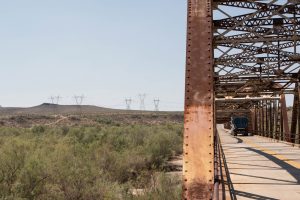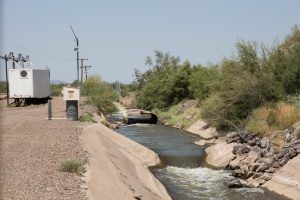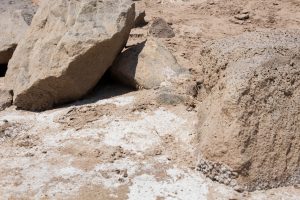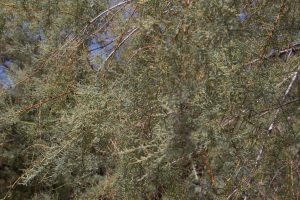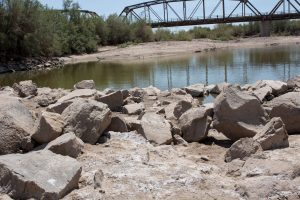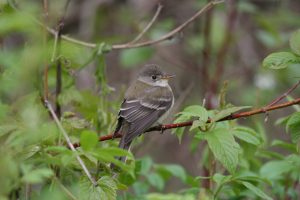- Slug: BC-CNS-Cedar trees. About 825 words.
- Photos available (thumbnails and captions below)
- Graphic available (embed code below)
By SHAYLA HYDE
Cronkite News
BUCKEYE — Local leaders say salt cedar trees are invading the Gila River, causing flood andfire hazards and choking native vegetation and wildlife habitats. They say it’s time for the trees, planted a century ago to slow erosion, to make their final stand.
Buckeye Mayor Jackie Meck said the trees are an invasive species and removing them is a priority. Environmentalists worry removing the salt cedar trees without careful moves to replace them could leave endangered birds without a home.
“Today we are faced with fire, with flood,” Meck said. “It’s critical that we get these salt cedars taken out.”
It’s taken a decade, $5 million and numerous government officials to come up with plans and permits to topple the 18 miles of trees lining the river in the southwest Valley. Meck said cutting down and removing the trees is tentatively set to take place by the end of the year.
Trying to find money and tackling a complex bureaucracy of filing for federal permits has taken two decades, according to Adam Copeland, a Buckeye senior planner. But workers could finally start cutting down the trees by December.
Officials with Buckeye, Goodyear, Avondale and the Maricopa County Flood District are collaborating to replace the salt cedars with other native vegetation. The restoration plan covers the river bed reaching from Litchfield Road in Avondale to State Route 85 in Buckeye.
Buckeye officials’ long-term vision – years in the future — is to develop the Gila River area into a park for the public to enjoy, along the lines of the San Antonio Riverwalk.
The menace
Salt cedars – which look like oversized shrubs – have grown along swaths of the Gila River bed, stretching from a quarter-mile wide to more than a mile wide in some areas. The 30,000 residents living in the river’s floodplain risk the possibility of flooding during heavy rain, Meck said.
A flood in 1978 forced residents in Hopeville, a Buckeye community, to move elsewhere in the area.
Steven Larson, a Buckeye real-estate agent, said the flood was “horrendous.”
Fire is another danger. Copeland said salt cedars burn hotter than other trees and, because they are packed so tightly, fires can spread easily.
And salt cedar trees suck up water — 200 to 300 gallons of water a day — making it tough for native vegetation to survive.
Salt cedars, originally brought to Arizona in the 1800s, take over native plants’ territory. Only one to two cottonwood trees grow per acre along the river bed, Copeland said. About 3,000 to 4,000 salt cedar trees, also known as tamarisk trees, crowd into one acre.
Copeland and George Diaz, Buckeye’s government relations manager, have learned about the salt cedars in workshops over five years. They say they have worked to conquer a maze of regulations governing what they need to do to get rid of them.
The battle
Consider sorting through regulations regarding aquatic habitat restoration, with documents named Nationwide Permit 27. Copeland said it can take months, even years to apply and get through the process.
Then, they have to come up with the money.
A grant paid for the removal of a 40-acre plot. Copeland hunts for grants, like those for riparian habitat and fire mitigation. He scopes out state and federal programs and scraps for money from non-profits such as the Walton Family Foundation.
The takedown
Copeland and Diaz decided the “hack and squirt” method would be the best way to get rid of salt cedars. Workers will cut down the trees in 40-acre plots, spray the leftover stumps with herbicide and throw any remains into an incinerator to finish the job.
They had learned a humbling lesson after cutting down the first 40-acre plot: with no herbicide to deter growth, the trees grew back.
Inmates at the Lewis prison in Buckeye will help cut down the trees, city officials said.
The concerns
Sandy Bahr, director of the Sierra Club’s Grand Canyon chapter, said salt cedars have to be replaced with other trees to protect wildlife and birds that depend on the vegetation to survive.
“It’s not just what needs to be removed but what needs to be planted,” Bahr said.
The Southwestern Willow Flycatcher, an endangered species, nests in the shade and foliage of salt cedars.
Robin Silver, co-founder and board member of the Center for Biological Diversity, is worried tree removal would happen too quickly.
“There needs to be a transition,” said Silver, who is also vice president of the Maricopa Audubon Society.
Kelly Wolff-Krauter, habitat design director for Arizona Game and Fish, said wildlife and birds will be protected. She’s working with Buckeye and other officials on the restoration plan.
She said protecting the flycatcher includes transplanting native cottonwood and willow trees to replace the salt cedar trees. That will happen during the season birds aren’t nesting in the trees.
If there are complications, the U.S. Fish and Wildlife Service will step in, Wolff-Krauter said.
^__=
Graphic embed code:
<script src=”https://urldefense.proofpoint.com/v2/url?u=https-3A__infograph.venngage.com_js_embed_v1_embed.js&d=DwIFaQ&c=l45AxH-kUV29SRQusp9vYR0n1GycN4_2jInuKy6zbqQ&r=FQ3dpNnxrYDI7NPgKcoHEk7ogh1VgynDr0h024Olpuc&m=PKB6SWeIhLD5KsPBz52X8PJMivr8d8od-GF_KZ398DE&s=gM2iYlwtQHklIMGCc9p_fBgTpVpJgZpxwwWUHTtDmjQ&e= ” data-vg-id=”300718”data-title=”Salt Cedar Tree Removal” data-w=”580” data-h=”410”></script>
